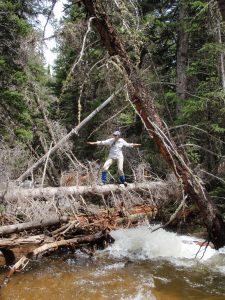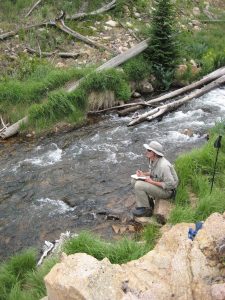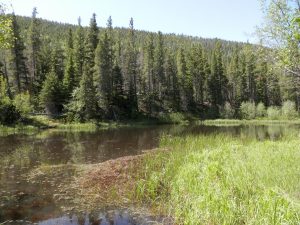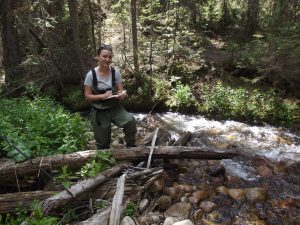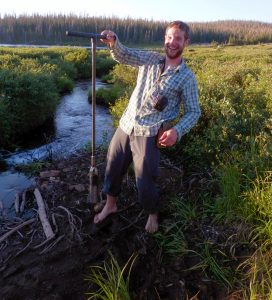Here’s what we’ve completed thus far:
Crossing A Threshold: The Legacy of 19th-Century Logging on Logjams and Carbon Storage in Front Range Headwater Streams – Natalie Beckman, PhD Dissertation
Natalie’s dissertation work tested the hypothesis that wood loads and logjams in streams draining old-growth forests differ significantly from those in younger forests. Beckman (2013) describes the primary findings from the work, including: streams in old-growth forests contain greater volumes of large wood, more closely spaced ramp and bridge pieces that can act as key pieces to form channel-spanning logjams, and more logjams per kilometer of stream. Logjams in old-growth forests trap a greater volume of organic matter: riparian forest stand age and valley geometry explain 73% of the variation in organic carbon in the form of wood and finer organic matter stored within a stream. Natural disturbances such as wildfires and blowdowns tend to increase the amount of organic carbon stored within streams, whereas human disturbances such as logging reduce carbon storage within streams. Size of jams, number of jams per kilometer of stream, and carbon storage within jams correlate most strongly with reach-scale variables rather than exhibiting consistent downstream trends, implying that management to retain or reintroduce large wood and logjams is most effective at the reach-scale. Increased total wood load and decreased spacing between key pieces are the most effective characteristics for promoting formation of logjams within a stream.
References
Beckman N. 2013. Crossing a threshold: the legacy of 19th-century logging on logjams and carbon storage in Front Range headwater streams. PhD dissertation, Colorado State University.
Beckman ND, Wohl E. 2014. Organic carbon storage in mountainous headwater streams: the role of old-growth forest and logjams. Water Resources Research 50: 2376-2393.
Beckman ND, Wohl E. 2014. Effects of forest stand age on the characteristics of logjams in mountainous forest streams. Earth Surface Processes and Landforms 39: 1421-1431.
Great River Wood Dynamics, Slave River and Great Slave Lake, Canada – Natalie Kramer, PhD Dissertation
Natalie’s dissertation focused on the dynamics of large wood in the Mackenzie River drainage basin of Canada. The Mackenzie River basin is a primary source of large wood to the Arctic Ocean, yet previous work on organic carbon dynamics in the Mackenzie and other Arctic river basins has focused on dissolved organic carbon and finer particulate organic carbon outputs to the ocean, rather than on organic carbon outputs in the form of large wood. Natalie’s work focused particularly on wood transport in the Slave River, a tributary to Great Slave Lake. Among her findings most relevant to carbon dynamics is that large wood entering Great Slave Lake is retained within the lake, rather than being transported downstream into the mainstem Mackenzie River. Some of the wood entering the Slave River delta forms large accumulations that block distributary channels. Much of the wood that is transported through the delta and enters the lake is transported by wind and water currents to limited portions of the lake shoreline. The repeated deposition of driftwood on these portions of the shoreline over centuries has facilitated accumulation of sediment and germination of vegetation on the wood-vegetation deposits. Natalie described these deposits as ‘driftcretions’ and distinguished different depositional morphologies, from mats to low ridges that record individual large storms (Kramer and Wohl, 2015). Driftwood deposited on the margins of Great Slave Lake thus forms a carbon deposit in its own right, but also facilitates trapping and retention of other organic matter containing carbon. Additional publications from Natalie’s dissertation include: a statistical examination of how different time-sampling intervals influence estimates of quantity of driftwood transport as recorded in time-lapse photographs (Kramer and Wohl, 2014); an extensive literature review and synthesis of quantitative and qualitative patterns of wood transport in rivers (Kramer and Wohl, 2017); and an examination of influences on large wood transport and storage along the Slave River using multiple lines of evidence (Kramer et al., 2017, Water Resources Research).
References
Kramer N. 2016. Great river wood dynamics, Slave River and Great Slave Lake, Canada. PhD dissertation, Colorado State University.
Kramer N, Wohl E. 2014. Estimating fluvial wood discharge using time-lapse photography with varying sampling intervals. Earth Surface Processes and Landforms 39: 844-852.
Kramer N, Wohl E. 2015. Driftcretions: the legacy impacts of driftwood on shoreline morphology. Geophysical Research Letters 42: 5855-5864.
Kramer N, Wohl E. 2017. Rules of the road: a qualitative and quantitative synthesis of large wood transport through drainage networks. Geomorphology 279: 74-97.
Kramer N, Wohl E, Hess-Homeier B, Leisz S. 2017. The pulse of driftwood export from a very large forested river basin over multiple time scales, Slave River, Canada. Water Resources Research 53: 1928-1947.
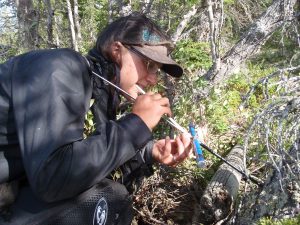
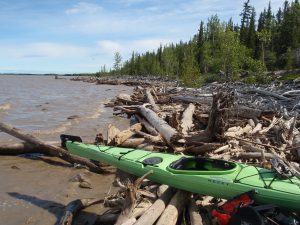 Spatiotemporal Variability of Floodplain Sediment and Organic Carbon Retention in Mountain Streams of the Colorado Front Range – Nicholas Sutfin, PhD Dissertation
Spatiotemporal Variability of Floodplain Sediment and Organic Carbon Retention in Mountain Streams of the Colorado Front Range – Nicholas Sutfin, PhD Dissertation
A pilot study of organic carbon storage along river corridors in the Colorado Front Range quantified carbon stored within downed, dead wood and floodplain sediment in relation to varying valley geometry. The pilot study suggested that relatively wide, low gradient valley segments were disproportionately important in storing organic carbon at the network scale (Wohl et al., 2012). Nick’s dissertation work greatly expanded this pilot study, with detailed quantification of organic carbon storage in 24 valley segments. As a population, these valley segments ranged in elevation from 2100 to 3050 m and had contributing drainage areas of 10 to 200 km2. Sutfin (2016) describes the primary findings from the work. Depth-averaged mean soil organic carbon content can be accurately estimated using systematic random sampling at approximately 10 locations. Soil organic carbon content correlates with soil moisture, sample depth, grain size, elevation of the floodplain surface relative to the active channel, thickness of soil at the sampling location, and valley geometry. Older pooled mean 14C ages of floodplain sediment at sites above 2900 m elevation compared to ages at sites below 2400 m elevation support previous work indicating elevational differences in flooding and floodplain disturbance regime in the Colorado Front Range. Observations of floodplain disturbance during the September 2013 flood indicate the amount of disturbed floodplain area increases exponentially downstream. Laterally unconfined valley segments store more organic carbon per unit area. Unconfined valley segments with single, rather than anabranching, channels tend to have saturated soils and store the greatest amounts of organic carbon. Additional journal articles based on this work are pending.
References
Suftin NA. 2016. Spatiotemporal variability of floodplain sediment and organic carbon retention in mountain streams of the Colorado Front Range. PhD dissertation, Colorado State University.
Sutfin NA, Wohl EE, Dwire KA. 2016. Banking carbon: a review of organic carbon storage and physical factors influencing retention in floodplains and riparian ecosystems. Earth Surface Processes and Landforms 41: 38-60.
Sutfin NA & Wohl E. 2017. Substantial soil organic carbon retention along floodplains of mountain streams. Journal of Geophysical Research Earth Surface 122: 1325-1338.
Sutfin NA & Wohl E. 2019. Elevational differences in hydrogeomorphic disturbance regime influence sediment residence times within mountain river corridors. Nature Communications 10: 2221. https://doi.org/10.1038/s41467-019-09864
Sutfin NA, Wohl E, Fegel T, Day N, Lynch L. 2021. Logjams and channel morphology influence sediment storage, transformation of organic matter, and carbon storage within mountain stream corridors. Water Resources Research 57: e2020WR028046. https://doi.org/10.1029/2020WR028046
Wohl E, Dwire K, Sutfin N, Polvi L, Bazan R. 2012. Mechanisms of carbon storage in mountainous headwater rivers. Nature Communications 3: 1263. Doi:10.1038/ncomms2274.
Instream Wood Loads and Channel Complexity in Headwater Southern Rocky Mountain Streams Under Alternative States – Bridget Livers, PhD Dissertation
Bridget’s dissertation research was conducted as part of a large, multidisciplinary research project that examined the effects of riparian forest stand age and disturbance history on mountain stream ecosystems. The study design focused on three populations of stream segments in the Southern Rockies of Colorado and Wyoming: streams draining old-growth forests; streams draining younger forests with a history of only natural disturbances such as wildfire or blowdowns; and streams draining younger forests with a management history as a result of timber harvest or other activities that occurred at least several decades before the study. Although analyses are ongoing for the biological data, preliminary results suggest that old-growth and naturally disturbed forests are significantly different than managed forests, even if the stand age of the naturally disturbed and managed forests are similar. These differences largely stem from significantly greater instream wood loads in old-growth and naturally disturbed forests. Greater wood loads equate to greater physical complexity, or spatial heterogeneity, in channels and floodplains and to greater organic carbon storage within channels (Livers and Wohl, 2016). Differences in wood load and physical complexity between streams in old-growth and naturally disturbed forests versus streams in managed forests reflect alternative states of stream ecosystem form and function, with the less complex and retentive state existing as a legacy from historical timber harvest and log floating. Additional journal articles based on this work are pending.
References
Livers Gonzalez B. 2016. Instream wood loads and channel complexity in headwater Southern Rocky Mountain streams under alternative states. PhD dissertation, Colorado State University.
Livers B, Wohl E. 2016. Sources and interpretation of channel complexity in forested subalpine streams of the Southern Rocky Mountains. Water Resources Research 52: 3910-3929.
Livers B, Wohl E, Jackson KJ, Sutfin NA. 2018. Historical land use as a driver of alternative states for stream form and function in forested mountain watersheds of the Southern Rocky Mountains. Earth Surface Processes and Landforms 43: 669-684.
Livers B, Wohl E. 2021. All logjams are not created equal. Geophysical Research Letters 126: e2021JF006076. https://doi.org/10.1029/2021JF006076
Evaluating Carbon Storage in Subalpine Lake Deltas in the Colorado Front Range and Washington Central Cascades – Dan Scott, MS Thesis
Dan’s thesis focused on understanding the contribution of subalpine lake deltas to the mountain river carbon pool. Subalpine lake deltas, potentially acting as the first long-term stop for carbon in a headwater network, provide a carbon storage record that largely reflect the carbon dynamics of their upstream basins. The study focused on comparing the magnitude of carbon storage in subalpine lake deltas between the Colorado Front Range and the Washington Central Cascades to evaluate the dominant controls on that storage in each region. Subalpine lake deltas are hot spots of carbon storage on the landscape, storing high concentrations of organic carbon, despite their small size on the landscape. Geomorphic factors that influence the transport, decomposition, and stability of organic carbon both in the upstream watershed and on the delta exert a stronger control on carbon storage than climate or primary production (Scott, 2015 ; Scott and Wohl, 2017). This project, along with the work of Nick Sutfin, provides the basis for Dan’s dissertation research, which broadens the scope of this investigation of carbon storage to entire mountain river basins.
References
Scott, DN. 2015. Evaluating Subalpine Lake Delta Carbon Storage in the Colorado Front Range and Washington Central Cascades. MS Thesis. Colorado State University.
Scott DN & Wohl E. 2017. Evaluating carbon storage in subalpine lake deltas. Earth Surface Processes and Landforms 42: 1472-1481.
Longitudinal Patterns of Organic Carbon Storage in Mountainous River Networks – Dan Scott, PhD Dissertation
Component 1: Logging Impacts on Soil and Wood Carbon Storage in a Mountain River Basin – Olympic Mountains, WA
Anthropogenic climate change is one of the biggest contemporary management concerns. Forest managers have the potential to reduce carbon emissions from logging. However, it is imperative for researchers to provide managers with a robust understanding of how humans affect carbon emissions over broad spatial and temporal scales in order to best manage for reduced carbon emissions. Although prior studies have examined the effects of logging on soil carbon over small temporal and spatial scales, the effect of logging on carbon storage in soils over large scales and in carbon sequestration hot spots such as mountainous regions has not been quantified. We undertook a watershed-scale examination of the total effect of logging on the carbon storage of mountain river basins. We conducted a paired-basin study on two basins near the Olympic National Park, one logged and one unlogged. In each basin, we measured organic carbon storage and age from the headwaters to the mountain front in soil and downed wood. This characterized how carbon storage changes down the length of a river network, identifying where carbon is focused in the basin. This project identified the magnitude of carbon storage change due to repeated logging and allows managers to consider forestry practices in terms of their integrated effects on carbon storage.
Component 2 – Assessing the Longitudinal Trends in and Controls on Carbon Storage in Mountain River Networks
In addition to Component 1, Dan examined carbon storage in mountain river basins in the Cascade Mountains of Washington and the Wind River Range of Wyoming. By examining a total of 4 diverse mountain river basins, he characterized longitudinal trends in carbon storage down a river basin and trends across varying regimes of disturbance (fires, logging) and climate to identify regions that may be sensitive to losses of carbon with predicted future changes in climate. This work can guide management strategies towards areas of high carbon storage, allowing for maximum effectiveness of carbon emissions mitigation strategies. The work also provides a more complete understanding of how mountain river basins contribute to carbon storage and the carbon cycle on the land.
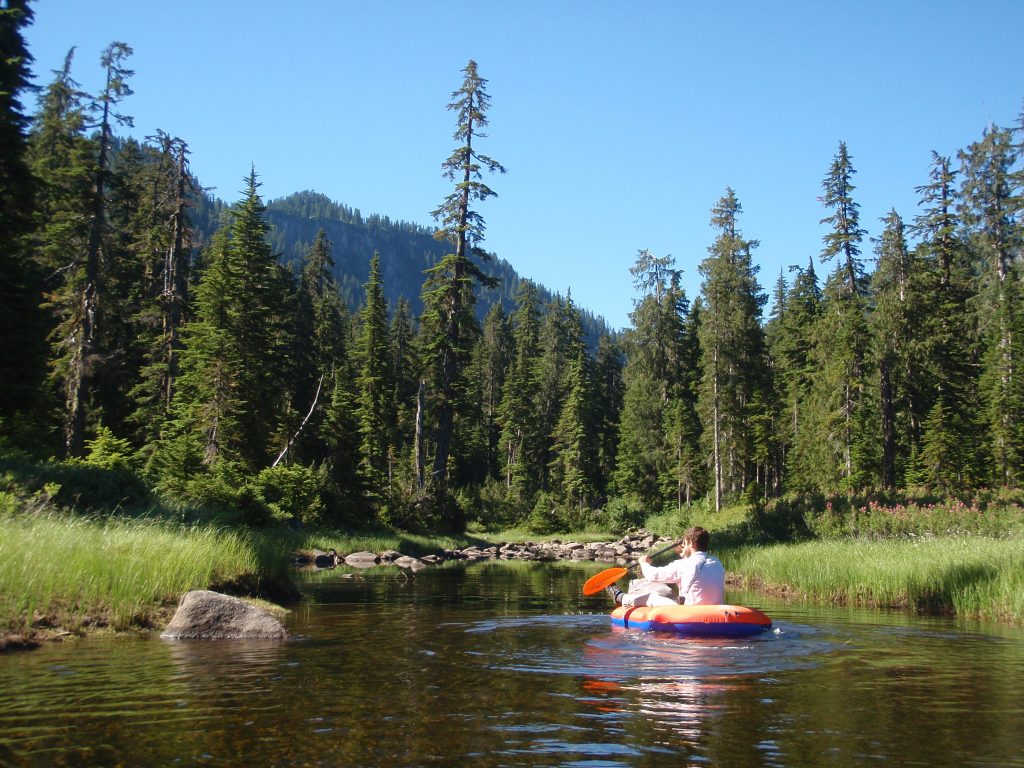
References
Scott, DN. 2018. Organic carbon storage in mountain river valley bottoms of the western United States. PhD Dissertation, Colorado State University.
Scott DN & Wohl E. 2018. Geomorphic regulation of floodplain soil organic carbon concentration in watersheds of the Rocky and Cascade Mountains, USA. Earth Surface Dynamics 6: 1101-1114.
Scott, DN & Wohl E. 2018.Natural and anthropogenic controls on wood loads in river corridors of the Rocky, Cascade, and Olympic Mountains, USA. Water Resources Research 54: 7893-7909.
Scott DN & Wohl E. 2020. Geomorphology and climate interact to control organic carbon stock and age in mountain river valley bottoms. Earth Surface Processes and Landforms 45: 1911-1925.
Floodplain organic carbon storage in the Yukon River basin – Katherine Lininger, PhD Dissertation
Understanding the global carbon cycle, or how carbon moves through the land, ocean, and atmosphere and where it is stored, is important for fully understanding climate change and how humans are affecting climate. One aspect of the carbon cycle that isn’t well understood is how much carbon is stored in rivers and floodplains. There may be more carbon in rivers and floodplains than previously thought, which is important for determining the movement of carbon between the land, ocean, and atmosphere.
As rivers transport sediment and organic matter, they can deposit those materials in their floodplains, storing carbon. Katherine quantified that storage in the boreal (subarctic) zone through research on floodplains in the Yukon Flats National Wildlife Refuge in interior Alaska. Her research informs how geomorphology and hydrology influence carbon dynamics.
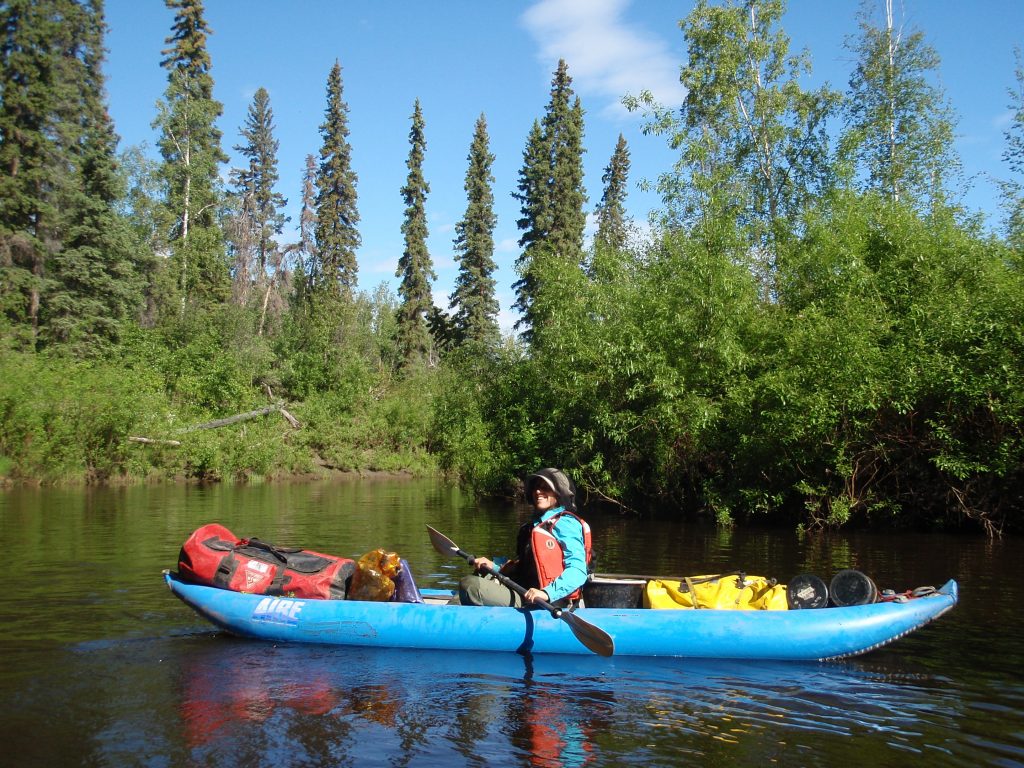
References
Lininger KB. 2018. Floodplain organic carbon storage in the central Yukon River basin, interior Alaska. PhD Dissertation, Colorado State University.
Lininger KB, Wohl E, Rose JR. & Leisz SJ. 2019. Significant floodplain soil organic carbon storage along a large high-latitude river and its tributaries. Geophysical Research Letters 46: 21221-2129.
Lininger KB, Wohl E, Rose JR. 2018. Geomorphic controls on floodplain soil organic carbon in the Yukon Flats, interior Alaska, from reach to river basin scales. Water Resources Research 54: 1934-1951.
In the absence of beaver: Characterizing changes in water, sediment and organic carbon storage in active and abandoned beaver meadows – DeAnna Laurel, PhD Dissertation
Beaver (Castor canadensis) are ecosystem engineers that shape the environment around them to better suit their habitat needs. Through dam building, beaver alter valley and stream morphology, trap sediment and nutrients, change the riparian vegetation and raise the riparian water table. Dams cause frequent overbank flow, leading to fine sediment deposition and a complex valley bottom with multi-thread channels, ponds and high biodiversity: this is known as a beaver meadow. Beaver alter carbon and nitrogen dynamics by trapping organic carbon with fine sediment behind dams and altering the storage and retention time of nitrogen. Human removal of beaver dams alters the stream geomorphology and hydrology, which in turn changes the riparian community structure. Much is known about how beavers alter the environment to their advantage when they move into a valley, but little has been studied about what occurs in these valleys when the beaver disappear, especially where dams have not been directly removed by humans. Quantifying changes in the morphology, sediment and organic carbon dynamics after the disappearance of beaver could be a helpful tool for assessing the restoration potential of these valley bottoms, and assessing the potential resilience of these ecosystems to changing climate. Rocky Mountain National Park in north central Colorado provides an opportunity to examine the differences between active and naturally abandoned beaver meadows. This project quantified surface and stratigraphic complexity, organic carbon storage, and inflow and outflow stream hydrographs for 10 beaver meadows in northern Colorado that range from currently active to sites abandoned by beaver across a range from the 1980s to 2013. Results indicate greater morphologic complexity, greater surface water storage and greater surface water retention time in active beaver meadows. Beaver meadows become progressively geomorphically and hydrologically simpler following abandonment.
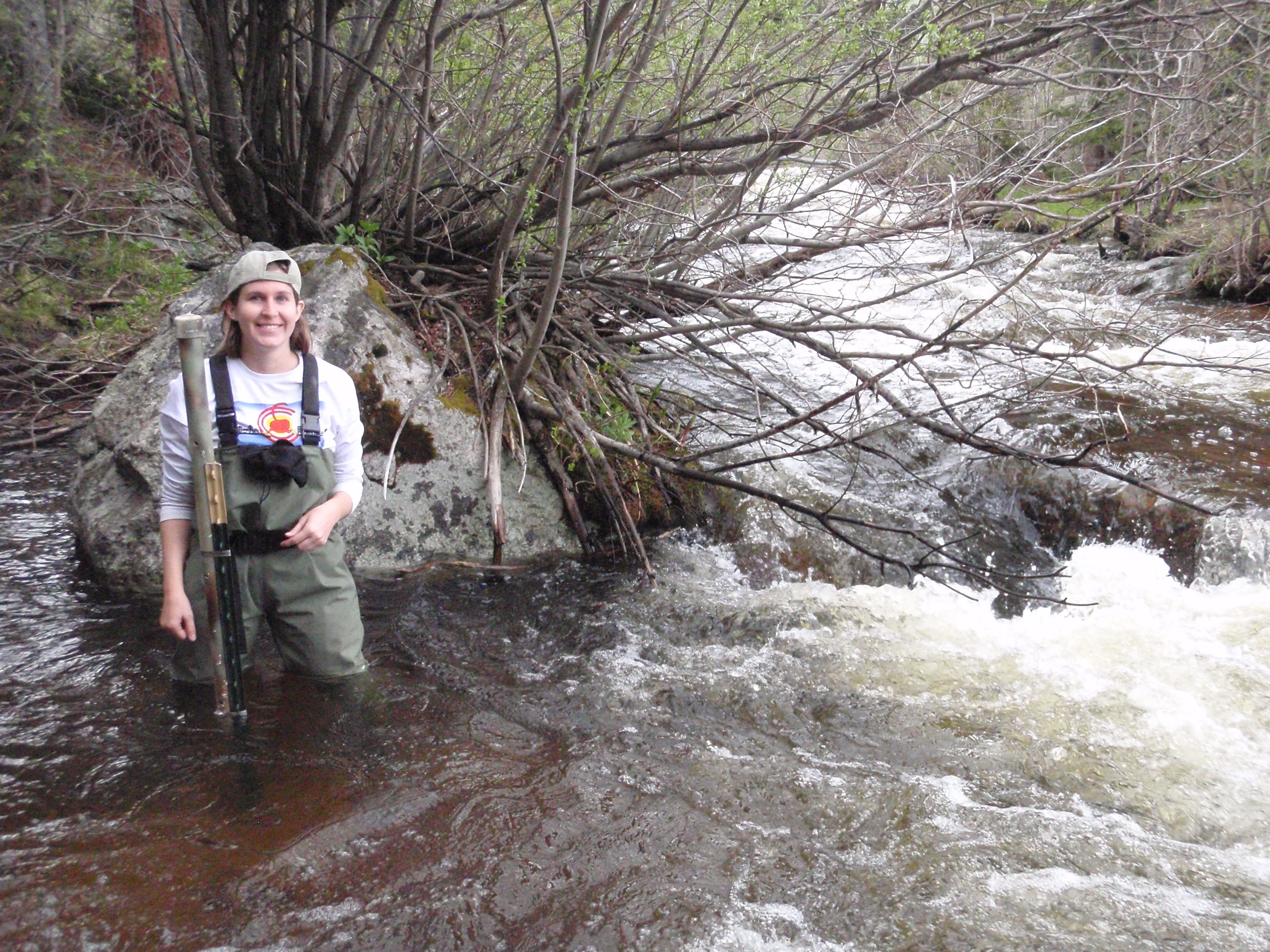
References
Laurel DJ. 2019. The effects of beaver engineering on Colorado mountain streams. PhD Dissertation, Colorado State University.
Laurel DJ & Wohl E. 2019. The persistence of beaver-induced geomorphic heterogeneity and organic carbon stock in river corridors. Earth Surface Processes and Landforms 44: 342-353.

